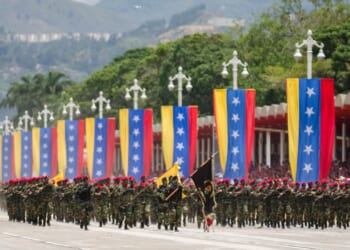France’s new submarine-launched ballistic missile (SLBM) is the latest upgrade in its line of M51 missiles—extending its range to as far as 6,200 miles (10,000 km).
The French Navy has a new nuclear missile.
Last week, the French military revealed the M51.3 submarine-launched nuclear ballistic missile, highlighting Paris’ continued investment in its military.
Why Is France Building a New Nuclear SLBM?
On Friday, French Armed Forces Minister Catherine Vautrin signed the operational commissioning of the M51.3 missile
The M51.3 missile is equipped with new oceanic nuclear warheads (TNO-2) that have a longer range, better precision, and deeper penetration capabilities than France’s existing arsenal. It is also better prepared to deal with advanced air defense systems.
This is the third version of the M51 submarine-launched nuclear warhead.
Although the French Navy has not disclosed the specific operational range of the new version of the M51, it is estimated to be between 5,000 and 6,200 miles. The existing M51.1 has a range of over 3,700 miles, and its successor, the M51.2, has an extended range of 5,600 miles—consistent with estimates surrounding the M51.3.
The new nuclear weapon will equip the French Navy’s four Le Triomphant class nuclear-powered ballistic missile submarines. Each submarine can carry up to 16 ballistic missiles, each equipped with an M51.3 nuclear warhead.
“The M51.3 ensures the continued credibility of the ocean-based component in the face of evolving enemy missile defenses,” the French Ministry of Defense stated.
For almost three decades, the French Navy has maintained a continuous-at-sea mission, with at least one nuclear-equipped submarine always at sea, ready to respond to a nuclear attack on France or NATO.
“This achievement embodies a major ambition of the 2024-2030 Military Programming Law: to accelerate the modernization of our capabilities and ensure the long-term credibility of our deterrence, the sovereign pillar of our security,” Vautrin said on X.
The French General Directorate for Armaments (DGA), Joint Staff, French Navy, Atomic Energy and Alternative Energies Commission (CEA), and ArianeGroup all worked together in the designing, developing, and production of the M51.3.
Nevertheless, while it was introducing the third version of the M51, the French military was already working on the fourth iteration of the nuclear weapon. In September, the General Directorate for Armaments awarded ArianeGroup a contract to design, develop, and produce the M51.4.
France Has an Independent Nuclear Arsenal
France is one of two NATO nations, alongside the United Kingdom, to operate its own nuclear arsenal separate from the American nuclear umbrella. The French military currently has an estimated 290 nuclear warheads—the fourth-largest arsenal in the world, behind Russia’s 5,580 warheads, America’s 5,044, and China’s approximately 500.
What is particularly interesting about the French nuclear arsenal is that it is completely homegrown. As France took its first step in developing nuclear weapons in 1954, it wanted to maintain its independence from other powers, including the United States and the United Kingdom. Spats with NATO in the 1950s and 1960s further strengthened Paris’s desire for an independent nuclear arsenal. The French military tested its first nuclear weapon in 1960 and its first thermonuclear munition in 1968.
France currently boasts the most powerful military force in Europe. Although the United Kingdom maintains a potent military force with strong capabilities on sea, air, and land—including nuclear weapons—years of budgetary cuts have diminished London’s military capabilities. Paris also maintains an active foreign policy agenda, especially on European affairs. The upgrade of the M51 missile represents another example of France’s ambition to maintain a powerful military with global force projection capabilities.
About the Author: Stavros Atlamazoglou
Stavros Atlamazoglou is a seasoned defense journalist specializing in special operations and a Hellenic Army veteran (national service with the 575th Marine Battalion and Army HQ). He holds a BA from the Johns Hopkins University and an MA from the Johns Hopkins’ School of Advanced International Studies (SAIS). His work has been featured in Business Insider, Sandboxx, and SOFREP.
Image: Shutterstock / Anelo.















